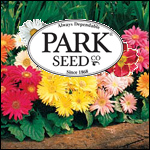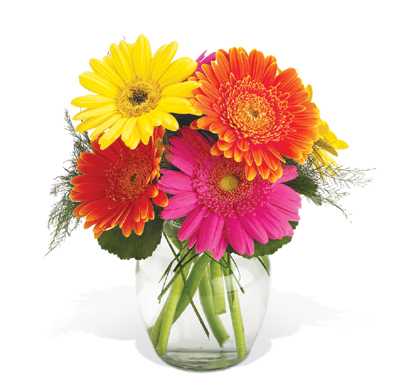Gerbera Daisies (Gerbera Jamesonii) can in fact be grown as perennials indoors, flowering all year long. Caring for them as a houseplant not only livens up your home but purifies your indoor air of toxins. They are listed in the top 12 “Green” air cleaners by NASA. People are catching onto this fact, but they haven’t quite figured out how to grow them and care for them. 
You can purchase giant gerber daisies at your local garden center or you can buy them online. The other alternative is to purchase seeds and grow your own. Some people are successful at germinating the seeds of the gerbera daisy plants they bought. The seeds have a short shelf life so you will want fresh seeds wherever you get them.
Gerbera Daisy Potted Plants
www.directgardening.com – A mixed array of colors. 1 plant for $3.50. 4 are only $10.50.
www.springhillnursery.com – Choose from red, pink, white, orange, and yellow. 1 plant for $5.99.
Gerbera Daisy Seeds
Park Seed Co. sells giant gerbera daisy seeds in a rainbow mix. 1 packet is $3.50. Click the ParkSeed banner at the left of this blog to go to their website. Making a purchase through that banner helps support me.
How to Grow Gerbera Daisies From Seeds
For earliest flowering start the seeds indoors. The seeds have fuzz on one end. The thin ones can sometimes be infertile, so you want to look for the fat ones. When you plant them make sure to place the seeds vertically with the fuzz on top. Plant them directly in a shallow container with moist soil. Peat moss or peat moss pellets work well. You want them just under the soil line so that the little fuzz is almost poking out. They need light and warmth to germinate so place the pot in a warm sunny location that’s about 70 degrees. Germination takes around 15-20 days at 70 degrees. I recommend covering the pot with clear plastic wrap as this will keep the soil warm and moist. Always make sure the soil is moist when germinating.
After the seeds sprout provide plenty of light and avoid excessive watering and drafts. When 4 leaves develop you can transplant them to larger pots. Gerbera roots are quite sensitive so you have to be gentle when handling them. If you want to grow them outside set the pots outside in a protected area to harden for 3 days. Then plant them in compost rich garden soil with plenty of sun and water them well initially. Adding some high energy fertilizer (high potassium) in with the water will help grow vibrant flowers.
How to Care For Gerbera Daisies
Gerbera daisies flower best when planted in 6 or more hours of direct sunlight each day. A high source of light can give an abundance of flowers. Gerber daisies need to be kept evenly moist but they should be allowed to dry slightly before watering. Gerber daisies require well-drained potting soil that is nutrient rich. In Mel Bartholomew’s book “All New Square Foot Gardening” he states that the very best soil for anything, plant or vegetable, is 1/3 compost, 1/3 peat moss, and 1/3 vermiculite. Healthy Gerberas are rarely ever bothered by pests, however fungus and stem rot is a common problem with over watered plants. You might want to remove old leaves regularly to prevent fungus infections.
Filed under: Gardening & Flowers, Gerber Daisies, Natural Health & Body | Tagged: air cleaner, gerber daisy, gerber daisy seeds, gerbera daisies, gerbera daisy potted plants, grow gerbera from seed, how to grow gerbera daisies indoors, purify air, seeds gerbera daisy seeds | 32 Comments »























